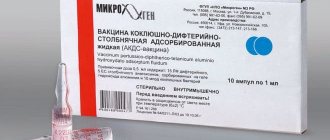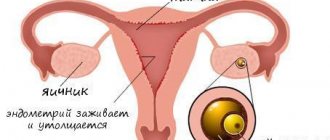Vaccine options
All modern vaccines for the prevention of viral hepatitis B are produced using genetic engineering technology.
A segment of the virus genome is introduced into the genetic material of baker's yeast, which is responsible for the production of the “Australian” (HBsAg) antigen. Vaccines consist of almost 90-95% antigen and only 5-10% of other components. The following vaccinations are used in Russia: “Vaccine against hepatitis B recombinant”, “Regevac V”, “Engerix V”, “Bubo-Kok”, “Bubo-M”, “Shanvak-V”, “Infanrix Hexa”, DPT-GEP B All of these vaccines are weakly reactogenic, interchangeable - that is, the course of vaccinations can be started with one vaccine and finished with another (although it is still preferable to vaccinate within the course with a vaccine from the same manufacturer). They are intended for vaccination of children and adults against hepatitis B.
The second, non-specific, but important component of vaccines is aluminum hydroxide. This substance is a so-called depositing agent in vaccinations and is designed to enhance the immune response. Its purpose is aimed not only at strengthening the immune response, but also at the dosed release of antigen from the site of hepatitis B vaccination. The need for it is dictated by the fact that, as a rule, vaccines based on only one antigen are weakly immunogenic, and in order to achieve the required levels of formed antibodies require either the introduction of more antigen or an increased response to it.
Vaccines
In the complex of preventive measures aimed at combating hepatitis B, compliance with sanitary and hygienic rules, thorough sterilization and the use of disposable instruments during medical procedures, and examination of donors remain important. Sanitary and hygienic measures ensure the interruption of natural transmission routes of the hepatitis B virus through personal hygiene items. Compliance with the rules of the anti-epidemic regime prevents the possibility of occupational infection in medical institutions and laboratories. However, given the variety of transmission routes of the hepatitis B virus, the large number of sources of infection, and the possibility of transmission of the virus from mother to child in utero and during childbirth, vaccination should be considered the only reliable method of preventing hepatitis B. Only vaccinations can protect newborns from infection; In addition, the use of hepatitis B vaccination can prevent the development of hepatocellular carcinoma and reduce the level of carriage of the virus in the population.
Immunization cost
| Immunoprophylaxis | Price |
| Engerix V (Belgium) adult | 800 rub. |
| Engerix V (Belgium) children's | 500 rub. |
| Euvax B (from 16 years old) | 800 rub. |
| Euvax B (under 16 years old) | 500 rub. |
| Infanrix Hexa (Belgium) | 5,200 rub. |
| Combiotech (Russia) for children | 500 rub. |
| Combiotech (Russia) adult | 850 rub. |
| Regevak (Russia) for children | 500 rub. |
| Regevak (Russia) adult | 800 rub. |
| The cost of examination before vaccination is 800 rubles. | |
*Preliminary inspection is paid separately.
Prevention of hepatitis B
Hepatitis B is an inflammation of liver tissue, which can lead to the death of its cells - hepatocytes and disruption of their basic functions. The disease occurs when certain viruses enter the body. Viral hepatitis is common among young and middle-aged patients. They cause severe liver damage. Routes of transmission: through blood (during medical manipulations and procedures, when using someone else's needles and syringes), through unprotected sexual contact.
Symptoms of hepatitis:
- febrile syndrome;
- intoxication, which leads to weakness, headaches, decreased performance, body aches;
- yellowing of the skin and mucous membranes;
- heaviness in the epigastrium, pain in the right hypochondrium and abdomen;
- tendency to skin hemorrhages, nosebleeds;
- diarrhea, flatulence;
- bitterness in the mouth;
- dark urine, light feces.
If hepatitis treatment is not started promptly, the risk of complications increases: cirrhosis, liver failure, liver cancer, cholecystitis. Patients with chronic viral hepatitis are monitored for life and can remain carriers even after therapy.
Vaccination as the main method of prevention
Vaccination against hepatitis B is the most effective way to prevent the development of the disease. It is also recommended to carefully select medical institutions that strictly treat the processing of instruments and pay increased attention to infection with viral hepatitis. It is prohibited to use other people's syringes, manicure accessories and personal hygiene products.
Viral hepatitis B is widespread among the young working population. The disease is caused by a DNA virus of the Orthohepadnavirus genus. When infected with hepatitis B, the virus must spread exclusively through biological fluids - blood, semen, vaginal secretions. The pathogen is also found in sweat, saliva and urine, but its quantity is usually not enough for the progression of the disease.
Our clinic is equipped with innovative technology that allows us to obtain reliable information about the extent of liver damage. Qualified specialists use modern methods of diagnosis, prevention and treatment, operating within the framework of world medical standards. You can make an appointment with a specialist at any time and get vaccinated against hepatitis B.
Principles and purposes of vaccination
About 780,000 people die every year from the consequences of hepatitis B. Vaccination is not only the main and important means of preventing viral hepatitis. It may also protect against primary liver cancer. The basis for preventing hepatitis B is the vaccine against this disease. WHO recommends that all infants should receive hepatitis B vaccination as soon as possible after birth, preferably within 24 hours. The dose given at birth should be followed by two or three subsequent doses to complete the vaccination series. In most cases, one of the following two options is considered optimal:
- a three-dose hepatitis B vaccination regimen, in which the first dose (of monovalent vaccine) is given at birth, and the second and third doses (of monovalent or combination vaccine) are given at the same time as the first and third doses of DPT vaccine;
- A four-dose regimen in which the first dose of monovalent vaccine given at birth is followed by 3 doses of monovalent or combination vaccine, usually given along with other vaccines as part of routine childhood immunization, is indicated for children born to mothers infected or with hepatitis B.
After a full series of vaccinations, more than 95% of infants, children of other age groups and young adults develop protective antibody levels. Protection lasts for at least 20 years and possibly a lifetime. All previously unvaccinated children and adolescents under 18 years of age should receive the vaccine if they live in countries with low or moderate endemicity. By the end of 2013, hepatitis B vaccine for infants had been introduced nationally in 183 countries. Global coverage of three doses of hepatitis B vaccine is estimated at 81%, and for Western Pacific countries it reaches 92%.
Hepatitis A: features of the course, indications and schedule
Botkin's disease, or viral hepatitis A, in comparison with hepatitis B and C, is less likely to be severe. Viruses in the body spread through the blood, mucous membranes and lymph, and then reach the liver. The incubation period lasts 2-4 weeks; it is during this period that carriers are most dangerous.
The early stage is similar to a common cold. Fever, muscle and head pain, nausea, and general malaise appear. After a few days, jaundice sets in: the whites of the eyes and skin become yellow, the urine darkens, and the stool becomes lighter. With timely and competent treatment, symptoms disappear after 3-5 weeks. After recovery, lifelong immunity is formed.
The danger lies in complications. Severe inflammation and pathologies of the biliary system occur. Vaccination is the only method of preventing infection in conditions of mass spread of the disease.
How does infection occur?
Hepatitis viruses of this type are very resistant to environmental conditions and remain active for up to 4 weeks in living rooms, at temperatures around zero - for several months, at -20 ° C and below - for many years.
Infection is possible through tap water, street food and fast food. The highest number of cases is in countries with low living standards.
Indications for vaccination
The vaccination is not included in the federal list of required immunizations, but is included in the list of vaccinations based on epidemiological indicators. It is carried out for those who are at risk:
- before traveling to exotic countries;
- after liver diseases and hemophilia;
- after contact with an infected person;
- medical workers;
- military personnel serving in unfavorable regions;
- food industry workers, including catering employees;
- those suffering from drug addiction;
- utility workers;
- living in pandemic regions.
Vaccination schedules
For immunization, inactivated drugs that do not lead to infection are used. In you can choose Havrix (UK), Vaqta (USA), Avaxim (France), GEP-A-in-VAK and GEP-A-in-VAK-POL (Russia).
Vaccination of adults and children is carried out twice with an interval of 6 months. up to 1.5 years. Immunity remains active up to 20 years. If antibodies decrease, re-vaccination is carried out.
Contraindications
- acute viral infections;
- exacerbation of chronic diseases;
- immunodeficiency;
- children under one year old;
- pregnancy;
- allergic reactions to previous vaccinations.
If a pregnant woman has acute indications, the doctor makes a decision on an individual basis.
Preparation for vaccination includes a standard examination by a general practitioner. The injection is given intramuscularly in the shoulder. Afterwards, skin redness and soreness may occur. There is no treatment for such symptoms; they go away on their own within a few days. If the temperature does not subside, a rash, convulsions, or breathing problems appear, you should immediately consult a doctor.
Vaccine effectiveness
The vaccine is highly safe and effective. More than one billion doses of hepatitis B vaccine have been administered worldwide since 1982. In many countries where typically 8% to 15% of children had chronic hepatitis B virus infection, vaccination has helped reduce rates of chronic infection among immunized children to less than 1% .
After a course of immunization, sufficient immunity is developed in 90% of vaccinated people. Vaccinations can reduce the incidence of hepatitis by 30 times and prevent at least 85-90% of deaths due to this disease. In addition, the risk of getting sick in those born to mothers who are carriers of the infection is reduced by 20 times.
Many researchers call the hepatitis B vaccine the “first cancer vaccine” because it prevents the development of HBV infection, which ultimately leads to hepatocellular carcinoma.
Post-vaccination reactions
Modern vaccinations against hepatitis B are characterized by an extremely high degree of purification, up to 95% of their volume is represented by antigen. In addition, vaccinations consist of only one antigen, the content of which is measured in micrograms. Both of these factors determine that in practice these vaccines are among the safest, “mildest”, and easily tolerated.
The most typical post-vaccination reactions to hepatitis B vaccines are local reactions (ie, those occurring at the injection site). Their frequency is fairly standard for all available vaccines - up to 10% (maximum) of vaccinated people report symptoms such as redness, slight thickening, and discomfort during active movements. The prevalence of local reactions is explained by the action of aluminum hydroxide, a substance that is specifically designed to enhance the inflammatory reaction at the site of drug administration so that as many immunocompetent cells as possible come into contact with the injected antigen.
Much less frequently, with a frequency of about 1% (maximum - 5%), the so-called so-called general reactions, i.e. affecting the body as a whole - a slight increase in body temperature, mild malaise, etc. All of the above reactions are normal (expected), appear within 1-2 days from the moment of vaccination and disappear without treatment within 1-2 days.
Vaccination schedule
Hepatitis B is extremely dangerous. The main method of transmission is parenteral (when working with blood, during operations, dental interventions, when giving injections). The second most common method is sexual transmission of the virus. At risk are people who lead an antisocial lifestyle and suffer from drug addiction and alcoholism. A person who has received the amount of virus necessary for infection becomes dangerous long before the first clinical symptoms of the disease appear (yellowness of the skin, detection of the virus in the blood, arthralgia, skin rash).
Experts have long developed a vaccine against hepatitis B and there is a specific schedule for administering the drug. It is recommended to adhere to it to obtain stable and long-lasting immunity - the body's resistance to an infectious pathogen.
Timing of vaccinations for children
The hepatitis B vaccination schedule was developed back in 1982. It hasn't changed since then.
All children are subject to vaccination:
- on the first day after birth;
- a month after the first vaccination;
- 6 months after the second vaccination.
Three-time administration provides stable protection against the pathogen.
For children from squeak groups whose mothers were infected before or during pregnancy. The vaccination schedule is as follows:
- on the first day and additionally administer antibodies to hepatitis B (passive immunization), which minimize the risk of developing the disease in response to vaccination;
- a month after the first vaccination, the vaccination is repeated;
- after 2 months another vaccination is given;
- after 12 months, the fourth vaccination is carried out.
Timing of vaccination for adults
Adults are vaccinated against hepatitis B with one of three regimens:
- 0-1-6. The second and third vaccinations are carried out 1 and 6 months after the first.
- 0-1-2-12. Fast way. An adult is vaccinated after 1, 2, 12 months.
- 0-7 days-21 days-12 months. Emergency immunization option. It is used in certain situations, for example, when a person travels to an epidemically unfavorable area.
It is impossible to predict the occurrence of potentially dangerous situations in which the risk of contracting hepatitis B is increased. Therefore, it is recommended that everyone be vaccinated, unless there are contraindications.
Contraindications
The only specific and absolute contraindication for vaccines against the hepatitis B virus is an allergy to products containing baker's yeast. Temporary contraindications: severe reaction (temperature above 40oC, swelling, hyperemia > 8 cm in diameter at the injection site) or complication (exacerbation of chronic diseases) to the previous administration of the drug. Routine vaccination is postponed until the end of acute manifestations of the disease or exacerbation of chronic diseases. For mild ARIs, acute intestinal and other diseases, vaccinations can be carried out after the temperature has normalized.
The best way to prevent hepatitis B is vaccination
The world is experiencing a rapid decline in the age of people susceptible to viral forms of hepatitis. Children infected at an early age with the causative agent of this infection, as a rule, become chronically ill. If in patients aged 40 years and older the acute forms can be completely cured, then in young people the disease more often develops into a difficult-to-treat chronic form with the risk of exacerbations and complications.
In this regard, in Russia, vaccination of children against hepatitis B is mandatory and is included in the National Calendar of Preventive Vaccinations, since the protective effect of antibodies during the full course of vaccination, starting from the day of birth, lasts for 20 years.
Vaccination schedules for children at risk (infected or untested mother, parents who are drug addicts, relatives with hepatitis or carriers) and other children differ. Most babies are given the vaccine within 12 hours of birth, then at one month of age, and the third at 6 months. For children at risk, the first and second vaccinations are carried out at the same time, the third - at the age of 2 months, the fourth - upon reaching 1 year.
If for some reason the second vaccination is not completed within the required period, the vaccination is considered invalid, and the scheme is carried out with a new administration of the first vaccination and, in accordance with the timing, the next two.
Vaccination against hepatitis B for adults is carried out according to the same scheme as for children who are not at risk. The effect of immunization will only be after all three doses of the vaccine are administered within the time frame specified by the schedule. If the timing of the second or third vaccination is not met, the vaccination will have to be repeated.
There are few contraindications for vaccination against hepatitis B: the presence of an allergic reaction to baker's yeast, including in the mother of a newborn, an acute infectious disease, prematurity of the newborn.
Within 1-2 days after the injection, symptoms of the immune system’s natural fight against a foreign protein may be observed: redness, itching, swelling or hardening, pain at the site of needle insertion, fever. Less common are weakness, general malaise, and in some cases headache and diarrhea. No measures should be taken to relieve these symptoms - they will disappear as soon as the immune system produces enough antibodies to suppress the virus.











